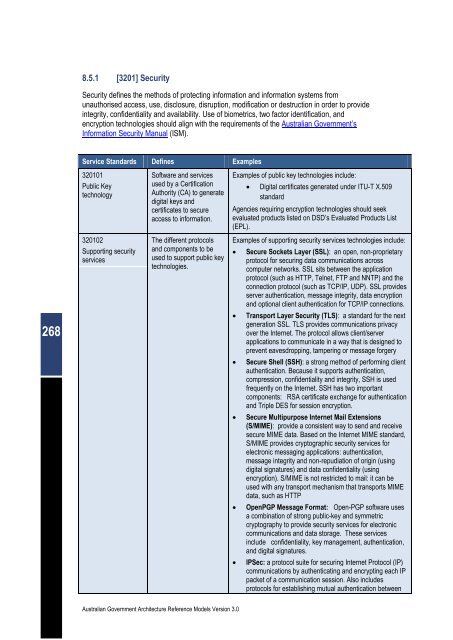Australian Government Architecture Reference Models Version 3.0
Australian Government Architecture Reference Models Version 3.0
Australian Government Architecture Reference Models Version 3.0
You also want an ePaper? Increase the reach of your titles
YUMPU automatically turns print PDFs into web optimized ePapers that Google loves.
268<br />
8.5.1 [3201] Security<br />
Security defines the methods of protecting information and information systems from<br />
unauthorised access, use, disclosure, disruption, modification or destruction in order to provide<br />
integrity, confidentiality and availability. Use of biometrics, two factor identification, and<br />
encryption technologies should align with the requirements of the <strong>Australian</strong> <strong>Government</strong>’s<br />
Information Security Manual (ISM).<br />
Service Standards Defines Examples<br />
320101<br />
Public Key<br />
technology<br />
320102<br />
Supporting security<br />
services<br />
Software and services<br />
used by a Certification<br />
Authority (CA) to generate<br />
digital keys and<br />
certificates to secure<br />
access to information.<br />
The different protocols<br />
and components to be<br />
used to support public key<br />
technologies.<br />
<strong>Australian</strong> <strong>Government</strong> <strong>Architecture</strong> <strong>Reference</strong> <strong>Models</strong> <strong>Version</strong> <strong>3.0</strong><br />
Examples of public key technologies include:<br />
� Digital certificates generated under ITU-T X.509<br />
standard<br />
Agencies requiring encryption technologies should seek<br />
evaluated products listed on DSD’s Evaluated Products List<br />
(EPL).<br />
Examples of supporting security services technologies include:<br />
� Secure Sockets Layer (SSL): an open, non-proprietary<br />
protocol for securing data communications across<br />
computer networks. SSL sits between the application<br />
protocol (such as HTTP, Telnet, FTP and NNTP) and the<br />
connection protocol (such as TCP/IP, UDP). SSL provides<br />
server authentication, message integrity, data encryption<br />
and optional client authentication for TCP/IP connections.<br />
� Transport Layer Security (TLS): a standard for the next<br />
generation SSL. TLS provides communications privacy<br />
over the Internet. The protocol allows client/server<br />
applications to communicate in a way that is designed to<br />
prevent eavesdropping, tampering or message forgery<br />
� Secure Shell (SSH): a strong method of performing client<br />
authentication. Because it supports authentication,<br />
compression, confidentiality and integrity, SSH is used<br />
frequently on the Internet. SSH has two important<br />
components: RSA certificate exchange for authentication<br />
and Triple DES for session encryption.<br />
� Secure Multipurpose Internet Mail Extensions<br />
(S/MIME): provide a consistent way to send and receive<br />
secure MIME data. Based on the Internet MIME standard,<br />
S/MIME provides cryptographic security services for<br />
electronic messaging applications: authentication,<br />
message integrity and non-repudiation of origin (using<br />
digital signatures) and data confidentiality (using<br />
encryption). S/MIME is not restricted to mail: it can be<br />
used with any transport mechanism that transports MIME<br />
data, such as HTTP<br />
� OpenPGP Message Format: Open-PGP software uses<br />
a combination of strong public-key and symmetric<br />
cryptography to provide security services for electronic<br />
communications and data storage. These services<br />
include confidentiality, key management, authentication,<br />
and digital signatures.<br />
� IPSec: a protocol suite for securing Internet Protocol (IP)<br />
communications by authenticating and encrypting each IP<br />
packet of a communication session. Also includes<br />
protocols for establishing mutual authentication between

















